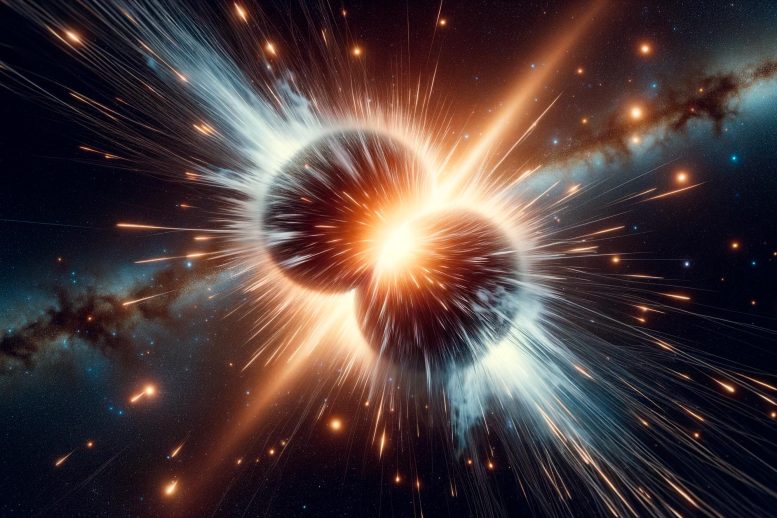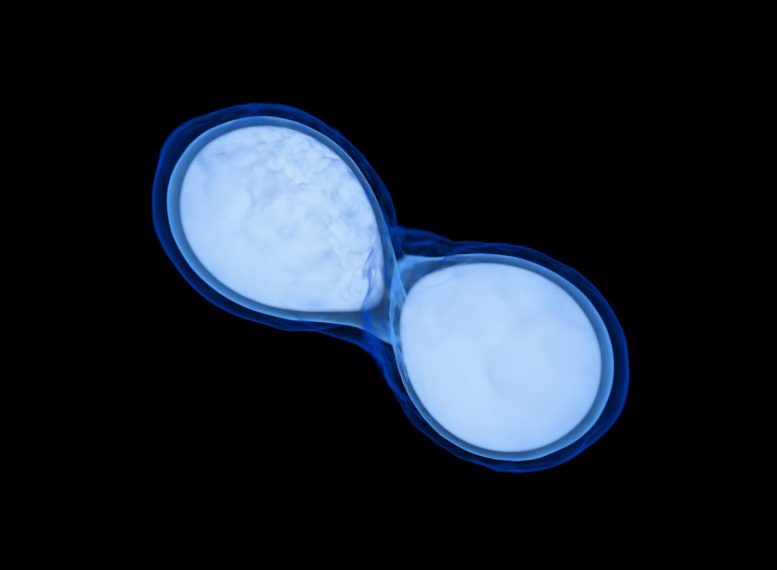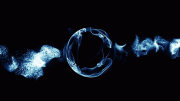
During the collision of binary neutron stars, hot neutrinos can briefly become trapped at the interface, staying out of equilibrium with the cold cores of the merging stars for 2 to 3 milliseconds. This interaction helps drive the particles toward equilibrium and offers fresh insights into the physics of such mergers. Credit: SciTechDaily.com
New simulations show that neutrinos created during these cataclysmic neutron star collisions are briefly out of thermodynamic equilibrium with the cold cores of the merging stars.
Recent simulations by Penn State physicists have shown that in binary neutron star mergers, hot neutrinos can be briefly trapped and remain out of equilibrium, providing new understanding of these cosmic events. This research emphasizes the role of simulations in studying phenomena that cannot be experimentally replicated.
What Happens When Neutron Stars Collide?
When stars collapse, they often leave behind incredibly dense but relatively small and cold remnants called neutron stars. If two stars collapse in close proximity, the leftover binary neutron stars spiral in and eventually collide, heating the point of collision to extreme temperatures.
New simulations of these events show hot neutrinos — tiny, essentially massless particles that rarely interact with other matter — that are created during the collision can be briefly trapped at these interfaces and remain out of equilibrium with the cold cores of the merging stars for 2 to 3 milliseconds. During this time, the simulations show that the neutrinos can weakly interact with the matter of the stars, helping to drive the particles back toward equilibrium — and lending new insight into the physics of these powerful events.
Groundbreaking Simulations of Neutron Star Mergers
A paper describing the simulations, by a research team led by Penn State physicists, was published recently in the journal Physical Reviews Letters.
“For the first time in 2017, we observed here on Earth signals of various kinds, including gravitational waves, from a binary neutron star merger,” said Pedro Luis Espino, a postdoctoral researcher at Penn State and the University of California, Berkeley, who led the research. “This led to a huge surge of interest in binary neutron star astrophysics. There is no way to reproduce these events in a lab to study them experimentally, so the best window we have into understanding what happens during a binary neutron star merger is through simulations based on math that arises from Einstein’s theory of general relativity.”

Volume rendering of density in a simulation of a binary neutron star merger. New research shows that neutrinos created in the hot interface between the merging stars can be briefly trapped and remain out of equilibrium with the cold cores of the merging stars for 2 to 3 milliseconds. Credit: David Radice, Penn State
Neutron Star Composition and Collision Dynamics
Neutron stars get their name because they are thought to be composed almost entirely out of neutrons, the uncharged particles that, along with positively charged protons and negatively charged electrons, make up atoms. Their incredible density — only black holes are smaller and denser — is thought to squeeze protons and electrons together, fusing them into neutrons. A typical neutron star is only tens of kilometers across but has about one-and-a-half times the mass of our Sun, which is about 1.4 million kilometers across. A teaspoon of neutron star material might weigh as much as a mountain, tens or hundreds of millions of tons.
“Neutron stars before the merger are effectively cold, while they may be billions of degrees Kelvin, their incredible density means that this heat contributes very little to the energy of the system,” said David Radice, assistant professor of physics and of astronomy and astrophysics in the Eberly College of Science at Penn State and a leader of the research team. “As they collide, they can become really hot, the interface of the colliding stars can be heated up to temperatures in the trillions of degrees Kelvin. However, they are so dense that photons cannot escape to dissipate the heat; instead, we think they cool down by emitting neutrinos.”
Insights From Neutrino Behavior in Star Mergers
According to the researchers, neutrinos are created during the collision as neutrons in the stars smash into each other and are blasted apart into protons, electrons and neutrinos. What then happens in those first moments after a collision has been an open question in astrophysics.
To try to answer that question, the research team created simulations requiring massive amounts of computing power that model the merger of binary neutron stars and all of the associated physics. The simulations showed for the first time that, however briefly, even neutrinos can be trapped by the heat and density of the merger. The hot neutrinos are out of equilibrium with the still cool cores of the stars and can interact with the matter of the stars.
“These extreme events stretch the bounds of our understanding of physics and studying them allows us to learn new things,” Radice said. “The period where the merging stars are out of equilibrium is only 2 to 3 milliseconds, but like temperature, time is relative here, the orbital period of the two stars before the merge can be as little as 1 millisecond. This brief out-of-equilibrium phase is when the most interesting physics occurs, once the system returns to equilibrium, the physics is better understood.”
The researchers explained that the precise physical interactions that occur during the merger can impact the types of signals that could be observed on Earth from binary star mergers.
“How the neutrinos interact with the matter of the stars and eventually are emitted can impact the oscillations of the merged remnants of the two stars, which in turn can impact what the electromagnetic and gravitation wave signals of the merger look like when they reach us here on Earth,” Espino said. “Next-generation gravitation-wave detectors could be designed to look for these kinds of signal differences. In this way, these simulations play a crucial role allowing us to get insight into these extreme events while informing future experiments and observations in a kind of feedback loop.”
Reference: “Neutrino Trapping and Out-of-Equilibrium Effects in Binary Neutron-Star Merger Remnants” by Pedro Luis Espino, Peter Hammond, David Radice, Sebastiano Bernuzzi, Rossella Gamba, Francesco Zappa, Luís Felipe Longo Micchi and Albino Perego, 20 May 2024, Physical Review Letters.
DOI: 10.1103/PhysRevLett.132.211001
In addition to Espino and Radice, the research team includes postdoctoral scholars Peter Hammond and Rossella Gamba at Penn State; Sebastiano Bernuzzi, Francesco Zappa, and Luís Felipe Longo Micchi at Friedrich-Schiller-Universität Jena in Germany; and Albino Perego at Università di Trento in Italy.
Funding from the U.S. National Science Foundation; the U.S. Department of Energy (DOE), Office of Science, Division of Nuclear Physics; the Deutsche Forschungsgemeinschaft; and the European Union Horizon 2020 and Europe Horizon initiatives supported this research. Simulations were performed on Bridges2, Expanse, Frontera and Perlmutter supercomputers. The research used resources of the National Energy Research Scientific Computing Center, a DOE Office of Science User Facility supported by the Office of Science of the U.S. Department of Energy. The authors acknowledged the Gauss Centre for Supercomputing e.V.
for funding this project by providing computing time on the GCS Supercomputer SuperMUC-NG at the Leibniz Supercomputing Centre.









Be the first to comment on "When Stars Collide: Unveiling the Universe’s Hidden Particles"